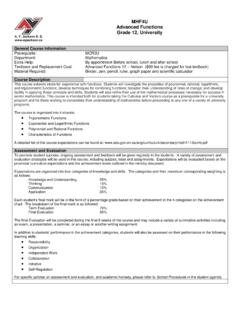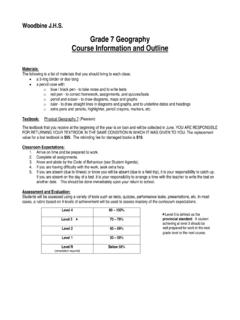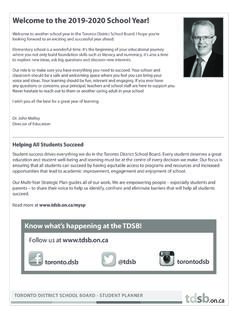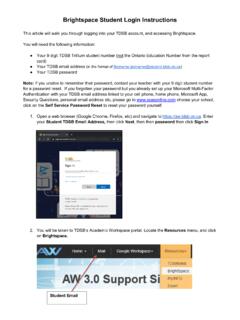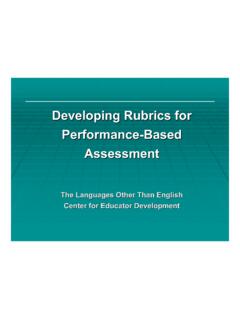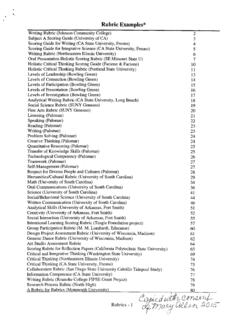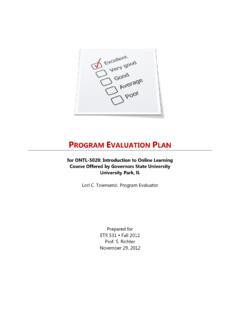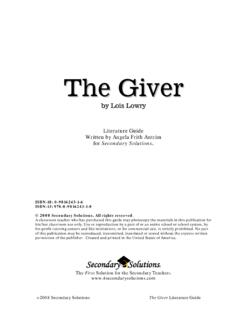Transcription of The Ontario Curriculum – Exemplars Grades 1–8 Writing
1 Ministry of Education and Training The Ontario Curriculum Exemplars Grades 1 8. Writing samples of Student Work: A Resource for Teachers 1999. ISBN 0-7778-8305-8. 98-011. Queen's Printer for Ontario , 1999. Printed on recycled paper Contents Introduction .. 2. Purpose .. 2. Background .. 3. Features .. 3. How the Rubrics Were Developed and Applied .. 4. How the samples Were Selected .. 5. Using the Writing samples .. 6. Teachers and Administrators .. 6. Parents .. 6. Students .. 7. The Writing Tasks .. 7. The Writing Process .. 7. Task Summaries .. 9. Student Writing Tasks and samples Grade 1: A Short Piece of Descriptive Writing ( My Favourite Toy ) .. 11. Grade 2: A Short Narrative ( My Adventure ) .. 25. Grade 3: A Letter (to a Favourite Author) .. 39. Grade 4: A Humorous Fictional Story ( The Day Gravity Failed ) .. 55. Grade 5: A Non-fiction Report ( A Person I Admire ) .. 73. Grade 6: A Summary Report ( Canada's Newest Territory ) .. 91. Grade 7: An Advertisement (for a New Food Product).
2 111. Grade 8: An Opinion Piece (a Letter to the Editor) .. 131. Glossary .. 149. Une publication quivalente est disponible en fran ais sous le titre suivant : Le Curriculum de l' Ontario Copies types de la 1re la 8e ann e : criture, 1999. This publication is available on the Ministry of Education and Training's World Wide Web site at The ministry grants permission to reproduce material in this publication for non-commercial purposes. Introduction In 1997, the Ministry of Education and Training published new Curriculum for Ontario elementary students. The new Curriculum is more specific than the previous Curriculum regarding both the knowledge and the skills that students are expected to acquire in each grade. In the language document, The Ontario Curriculum , Grades 1 8: Language, 1997, teachers are provided with the Curriculum expectations for language reading, Writing , and oral and visual communication and brief descriptions of four levels of student achievement on which to base their assessments of students' work (see page 9).
3 This resource booklet, The Ontario Curriculum Exemplars , Grades 1 8: Writing , 1999, focuses on Writing only and provides teachers, parents,1 and students with a selection of representative end-of-year samples of student writing2 based on the Curriculum expectations. In this provincial Curriculum Exemplars Writing project , teachers and administrators designed Writing tasks and rubrics (scoring scales), field-tested them in classrooms, suggested changes, administered the final tasks, marked the student Writing holisti- cally, and selected for inclusion in this booklet the samples that they felt represented the four levels of Writing achievement. The choice of samples reflects the professional judgement of teachers in the project , and the samples are not intended to be used as standards for the province. The process used for this project will serve as a model for boards, schools, and teachers in setting Writing tasks in the context of regular class- room work, developing rubrics, assessing the Writing of their own students, and plan- ning for the improvement of student work.
4 The samples selected for this resource illustrate each of the four levels of student achievement in Writing for students at the end of each grade and were completed by Ontario students in the last month of each grade. The samples provided have been reproduced as is , with no attempt to edit the students' work. The Writing is anony- mous, with no students, teachers, or schools identified. Purpose This booklet has been developed to: show the characteristics of student work at each level of achievement for each grade;. promote greater consistency in the assessment of student work from grade to grade and across the province;. 1. The word parents is used throughout this document to stand for parent(s) and guardian(s). 2. The ministry was given permission to publish the Writing samples in this document. 2. provide an approach to improving student learning by demonstrating the use of clear criteria applied to student Writing in response to clearly defined tasks and by including examples of possible feedback to students in the form of Teachers' Notes.
5 Show the connections between what students are expected to learn (the expecta- tions) and how their work can be assessed on the basis of levels of achievement;. promote the Writing process outlined on page 11 of The Ontario Curriculum , Grades 1 8: Language, 1997. Teachers, parents, and students are encouraged to examine these student samples , to think about the characteristics and descriptions of work at each level of achievement in the individual Grades , and to develop an understanding of how one level of achievement differs from another. Teachers might also wish to discuss the strategies they could use to enhance student learning and promote student achievement in writ- ing. Background Ontario school boards were invited to provide student Writing samples for the cur- riculum Writing Exemplars project . Students provided the Writing samples , while teachers and administrators participated in the following components of the project : the field-testing of the Writing tasks and the rubrics the collection of the samples of student work at the end of the school year the selection of the samples the review of the draft manuscript for this booklet The participation of Ontario teachers from all regions has been invaluable in develop- ing the material used in this booklet.
6 Teachers, some of them working with the Curriculum expectations and the achievement levels for the first time, contributed by: offering their time and classrooms for field-testing the materials;. suggesting revisions to the Writing tasks;. developing and revising the rubrics used to assess the Writing tasks;. submitting end-of-grade samples of student Writing ;. participating in staff-development sessions to build expertise in student assessment;. selecting the samples used to illustrate the four levels of achievement of student Writing at each grade level. In some jurisdictions, school councils were also involved in the project , with mem- bers participating in the staff-development sessions, the selection of the local samples , and the review of the draft document. Features This booklet contains: an overview of the student tasks and the teaching and learning strategies used to produce the Writing samples ;. task-specific assessment rubrics based on the categories and descriptions from the achievement-levels chart on page 9 of The Ontario Curriculum , Grades 1 8: Language, 1997.
7 Introduction 3. samples of student Writing for each grade level that reflect the four levels of achievement;. teachers' comments that explain why a particular achievement level was assigned to each piece of student Writing ;. a glossary of assessment terms. How the Rubrics Were Developed and Applied In this booklet, the term rubric means a scale, in this case one that describes levels of achievement for a particular complex task and guides the scoring of that task accord- ing to relevant criteria. To assess student achievement, the teacher chooses from dif- ferent descriptions of work that are specific to each level of achievement. In this pro- ject, a rubric was used for each Writing task to provide an effective means of assessing the particular type of student performance, to allow for consistent scoring of student performance, and to provide information to students on how to improve their work. Although rubrics were used effectively in this project , they are only one way to assess student achievement.
8 Other forms of classroom assessment include anecdotal records, checklists, tests, and teacher observation. Teachers select and use many assessment tools to assess and evaluate student achievement. For this project , a rubric was developed for each of the Writing tasks, on the basis of the achievement-levels chart on page 9 of The Ontario Curriculum , Grades 1 8: Language, 1997. The achievement levels for Writing focus on four categories of knowl- edge and skills: reasoning, communication, organization, and conventions. The brief descriptions in the achievement-levels chart apply in a general way to all language assessment. Each rubric contains the following components: the categories and the achievement levels ( , the framework) from page 9. the relevant criteria (descriptions of student learning) from page 9. the expectations for the grade level (level 3 on the achievement-levels chart is the provincial standard). the required components specific to each Writing task ( , the parts of a letter).
9 The rubrics for the Writing tasks are similar to the Writing scales used by the Education Quality and Accountability Office (EQAO) for the Grade 3 and Grade 6. provincial assessments in that both the rubrics and the EQAO scales are based on the Curriculum expectations and the achievement levels for language in Ontario . The rubrics differ from the EQAO scales in that they were developed to be used in the context of classroom instruction and assessment and to be applied to the one particu- lar form of Writing identified in each grade assignment. Each student participating in the Exemplars project prepared one Writing sample in response to a single task. 4 The Ontario Curriculum Exemplars , Grades 1 8: Writing , 1999. How the samples Were Selected After the elaborated descriptions in the rubrics had been reviewed and revised by all the teachers participating in the Writing Exemplars project , they then were used to assess the student Writing samples at both the district school board level and the provincial level.
10 The teachers used a process that is sometimes called consensus marking or teacher moderation : The teachers first reviewed all of their students' work samples and assigned a holis- tic score (from level 1 to level 4) to each sample. The teachers then reviewed the samples a second time, looking at all four cate- gories in the rubric to provide an analytic score ( , level 1 in Reasoning , level 2. in Communication ). Following these steps, the teachers assigned each sample an overall level based on both the holistic score and the analytic score, with reference to specific criteria requirements that had been met in the student sample. At the district school board level, groups of three or four other teachers for each grade level then reviewed the student work until they were able to reach consensus on the assigned level. This was done to ensure that the work being selected clearly illustrated that level of performance. All the Writing samples were submitted to a provincial selection team of teachers, which chose the samples for each level of each grade.

